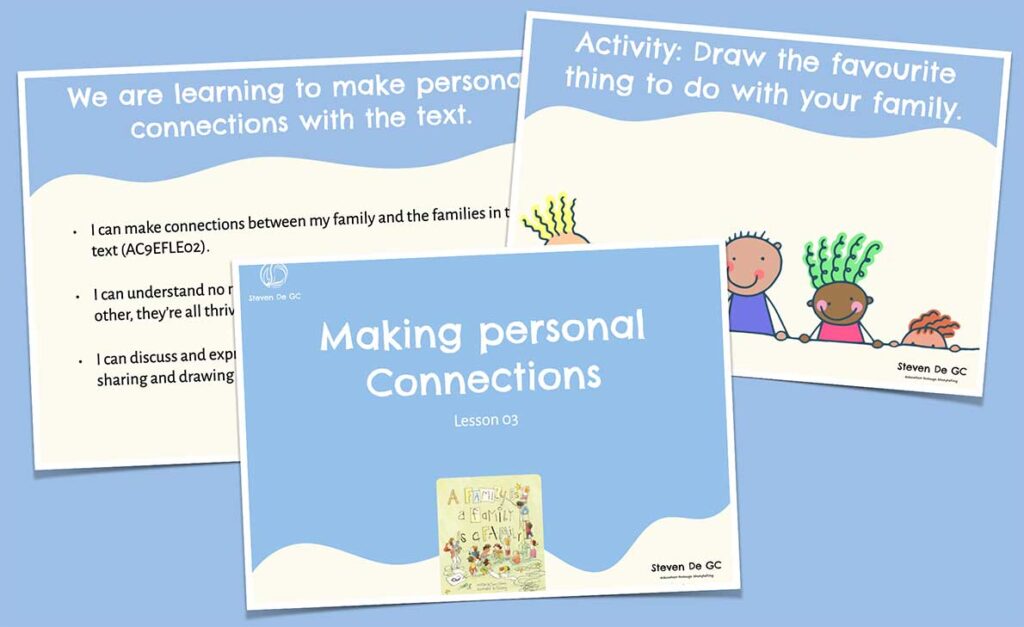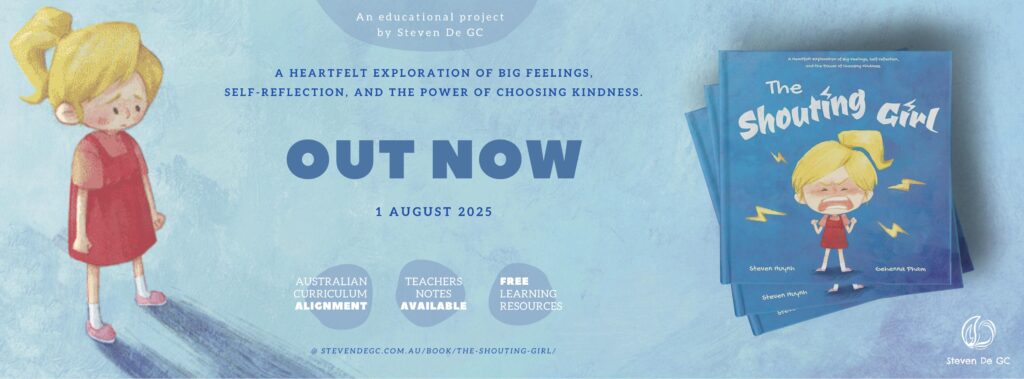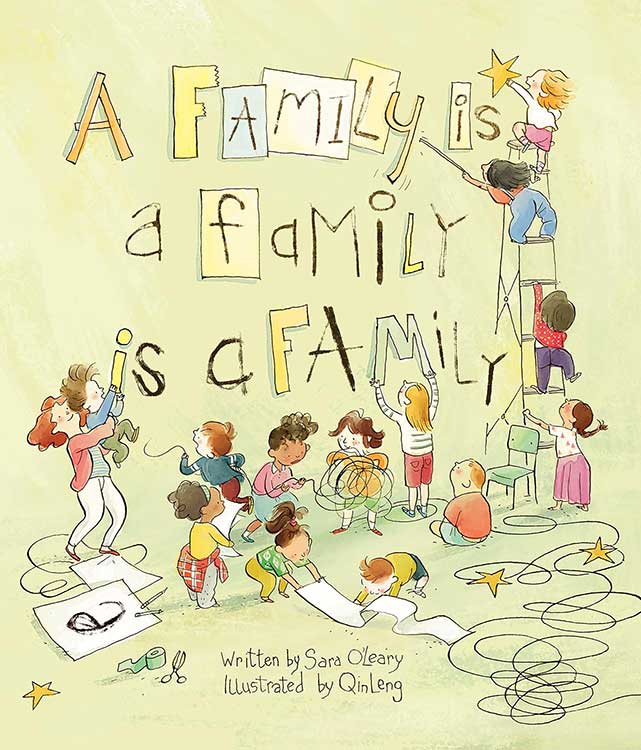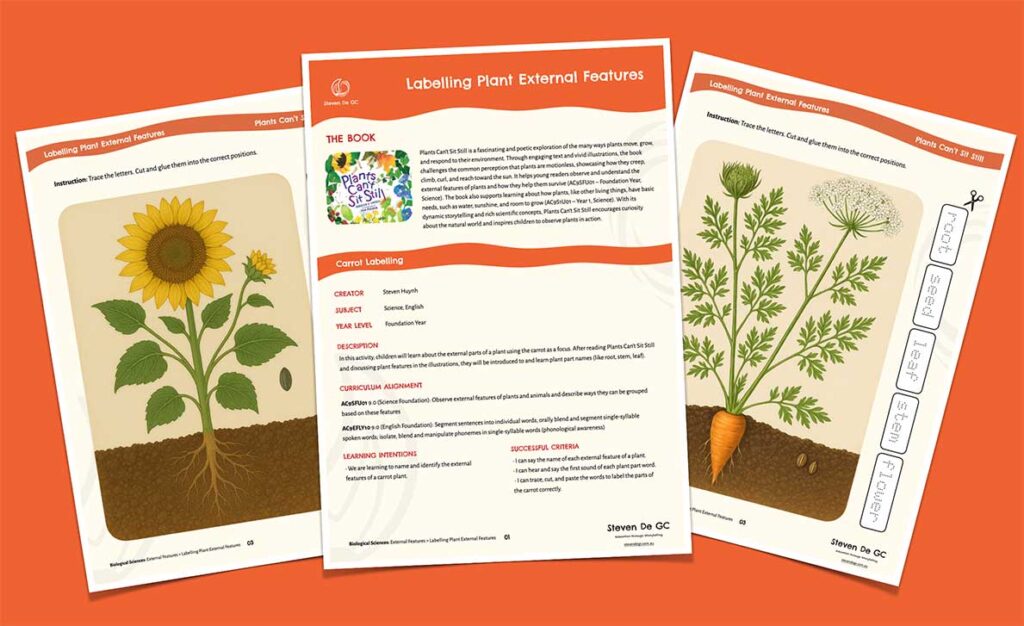- Review
- Revisit unique family photos and go through the questions:
- Can you find a family like yours in the book or the unique family photos?
- Is it okay to have a family that looks different from others?
- Revisit unique family photos and go through the questions:
- The Big Question
- Discuss the big question: What makes a family?
- What these different families have in common?
- What glues them together?
- Discuss the big question: What makes a family?
- Reading
- Model fluent reading with expression and intonation.
- Pause to remind kids to find the things the families have in common.
- Activity
- Discuss: What is your favourite thing to do with your family?
- Encourage children to use helpful sentence starters.
- Reflection
- Remind the key answer: What makes a family?
[T4R] A Family is a Family is a Family: L3 Making Personal Connections

The Book
A Family Is a Family Is a Family
Written by Sara O’Leary, illustrated by Qin Leng, published by Groundwood Books
This heartwarming book celebrates diverse family structures and the love that binds them together. Through a classroom discussion, children share stories about their families, highlighting the uniqueness of each one while reinforcing the idea that all families are special.
This book provides opportunities for young students to explore concepts of family by recognising and describing family members (AC9HSFK01 – Foundation Year, Humanities and Social Sciences). It also encourages children to develop a sense of self within their family (AC9HPFP01 – Foundation Year, Health and Physical Education) while practising personal and social skills to interact respectfully with others, particularly in understanding inclusion and acceptance (AC9HPFP02 – Foundation Year, Health and Physical Education).
With its gentle storytelling and wonderful illustrations, A Family is a Family is a Family fosters empathy, respect, and an appreciation for the many forms that family can take.
Resource creator
Steven Huynh
Level
Description
This is lesson 3 of the Talk For Reading (T4R) unit of A Family is a Family is a Family.
The lesson helps students make personal connections with the text through storytelling and discussion.
Learning Intentions
• We are learning to make personal connections with the text.
Successful Criteria
• I can make connections between my family and the families in the text (AC9EFLE02).
• I can understand no matter how different families are from each other, they’re all thrived by love (AC9HSFS03).
• I can discuss and express what I love doing with my family through sharing and drawing (AC9HSFS05).
Curriculum Alignment
AC9AVAFC01 9.0 (Visual Arts Foundation): Create arts works that communicate ideas
• creating arts works in a range of forms to communicate ideas from lived personal or social experiences; for example, creating a dance or scenes showing favourite activities such as games; using digital devices to record their peers playing a game and creating a voice-over that describes what’s happening; composing a song or chant about a favourite food or activity; drawing a home scene of people and animals
• creating works in response to inspiration from sources such as play, imagination, observation, literature, artworks from their cultures and communities or arts knowledge and skill development activities
• extending and varying known songs, chants or rhymes; for example, changing words, interpreting without using voice, adding movements/actions or improvising rhythm patterns as accompaniment
• manipulating objects, puppets, 2D images and/or available technologies to create or retell stories
• devising a chant/rap that a character from an animated series, a text or a fictional hero could use to communicate a health or sustainability message or to learn the steps in a process; recording the chant/rap using an available digital device and sharing live or via a school-managed space such as a learning management system
• repurposing materials and objects such as clothing or packing boxes as starting points for imagining and developing scenes and scenarios; for example, using packing boxes to create an imagined environment or vehicle
• considering as a class the characters and situations associated with a story and then re-imagining them by asking questions of the story, such as “What’s up?”, “What happens next?” or “What else might/could happen?” to support the development of their own socio-dramatic or miniature worlds play
AC9EFLE02 9.0 (English Language and Literacy Foundation): Respond to stories and share feelings and thoughts about their events and characters
• using drawing and beginning forms of writing to express personal responses to stories, poems or films
• discussing events and characters in texts, and connecting them to their own experiences
AC9HSFS03 9.0 (Humanities and Social Sciences Foundation): Share a perspective on information, such as stories about significant events and special places
• sharing aspects of events special to past generations of their family from provided stories and discussing why those events and places are special
• identifying a place in their local area that they like, and talking about why they like it and how they could care for it
AC9HSFS05 9.0 (Humanities and Social Sciences Foundation): Share narratives and observations, using sources and terms about the past and places
• creating a display about a special place or family event using photographs, artefacts and/or drawings
• using terms about time when talking about their experiences; for example, “then”, “now”, “yesterday”, “today”, “tomorrow”
• using appropriate terms to describe the direction and location of a place such as “near and far”, “above and below”, “beside and opposite”
Materials
- The Book: A Family is a Family is a Family.
- A black piece of paper (for the drawing activity)
Instructions
Downloads
| Free Version | Paid Version | |
|---|---|---|
| Material contents | Limited | Full access |
| Instructions | Not included | Included |
| Redownloads | 5 per download | Unlimited |
| Download | FREE DOWNLOAD | BUY WITH |




![[T4R] A Family is a Family is a Family Reading Unit for Foundation Year [T4R] A Family is a Family is a Family Reading Unit for Foundation Year](https://stevendegc.com.au/wp-content/uploads/2025/03/T4R-A-Family-is-a-Family-UnitOverview-1024x627.jpg)
![[T4R] Let’s Build a Boat: L11 Evaluation and Reflection [T4R] Let’s Build a Boat: L11 Evaluation and Reflection](https://stevendegc.com.au/wp-content/uploads/2025/05/LetsBuildaBoat-T4R-Lesson11-Cover-1024x626.jpg)
![[T4R] Let’s Build a Boat: L10 Summarising [T4R] Let’s Build a Boat: L10 Summarising](https://stevendegc.com.au/wp-content/uploads/2025/05/LetsBuildaBoat-T4R-Lesson10-Cover-1024x626.jpg)
![[T4R] Let’s Build a Boat: L9 Making Inferences [T4R] Let’s Build a Boat: L9 Making Inferences](https://stevendegc.com.au/wp-content/uploads/2025/05/LetsBuildaBoat-T4R-Lesson9-Cover-1024x625.jpg)
![[T4R] Let’s Build a Boat: L6 Writing a Boat-making Procedure [T4R] Let’s Build a Boat: L6 Writing a Boat-making Procedure](https://stevendegc.com.au/wp-content/uploads/2025/05/LetsBuildaBoat-T4R-Lesson6-Cover-1024x626.jpg)
![[T4R] Let’s Build a Boat: L5 Connecting to a Different Text [T4R] Let’s Build a Boat: L5 Connecting to a Different Text](https://stevendegc.com.au/wp-content/uploads/2025/05/LetsBuildaBoat-T4R-Lesson5-Cover-1024x626.jpg)
![[T4R] Let’s Build a Boat: L4 Literal Retrieval [T4R] Let’s Build a Boat: L4 Literal Retrieval](https://stevendegc.com.au/wp-content/uploads/2025/05/LetsBuildaBoat-T4R-Lesson4-Cover-1024x626.jpg)
![[T4R] Let’s Build a Boat: L3 Making Connections [T4R] Let’s Build a Boat: L3 Making Connections](https://stevendegc.com.au/wp-content/uploads/2025/05/LetsBuildaBoat-T4R-Lesson3-Cover-1024x625.jpg)
![[T4R] Let’s Build a Boat: L2 Making Predictions [T4R] Let’s Build a Boat: L2 Making Predictions](https://stevendegc.com.au/wp-content/uploads/2025/05/LetsBuildaBoat-T4R-L2-Cover-1024x627.jpg)
![[T4R] Let’s Build a Boat: L1 Background Knowledge [T4R] Let’s Build a Boat: L1 Background Knowledge](https://stevendegc.com.au/wp-content/uploads/2025/05/LetsBuildaBoat-T4R-L1-Cover-1024x626.jpg)

Leave a Reply